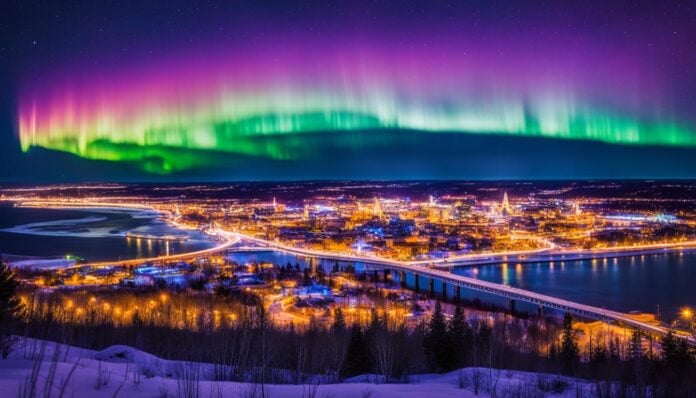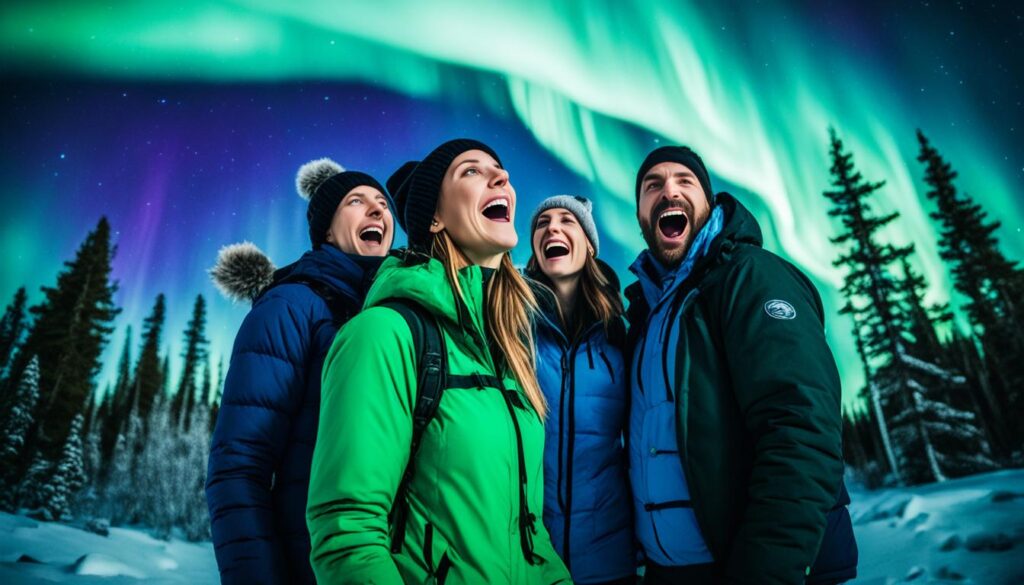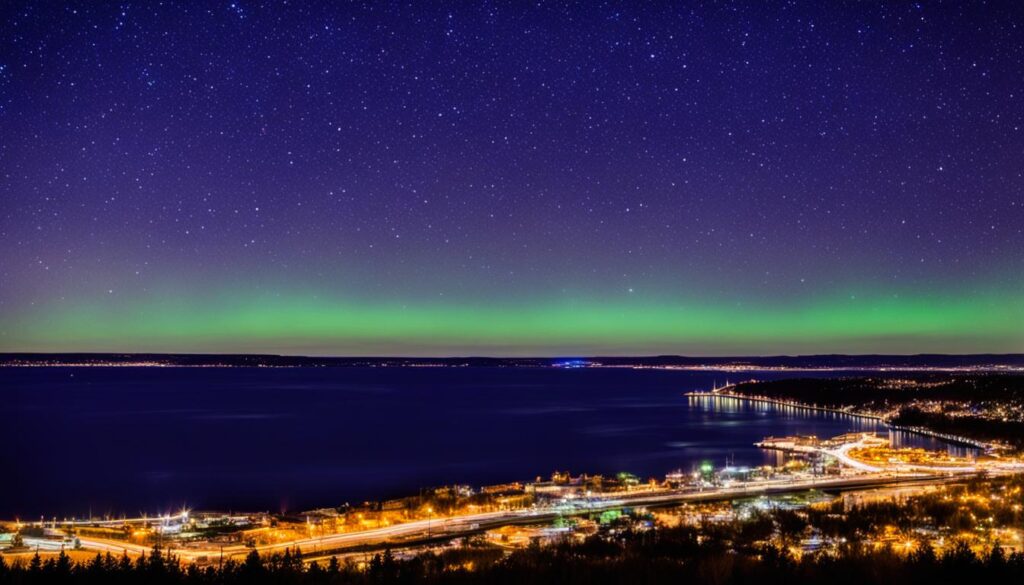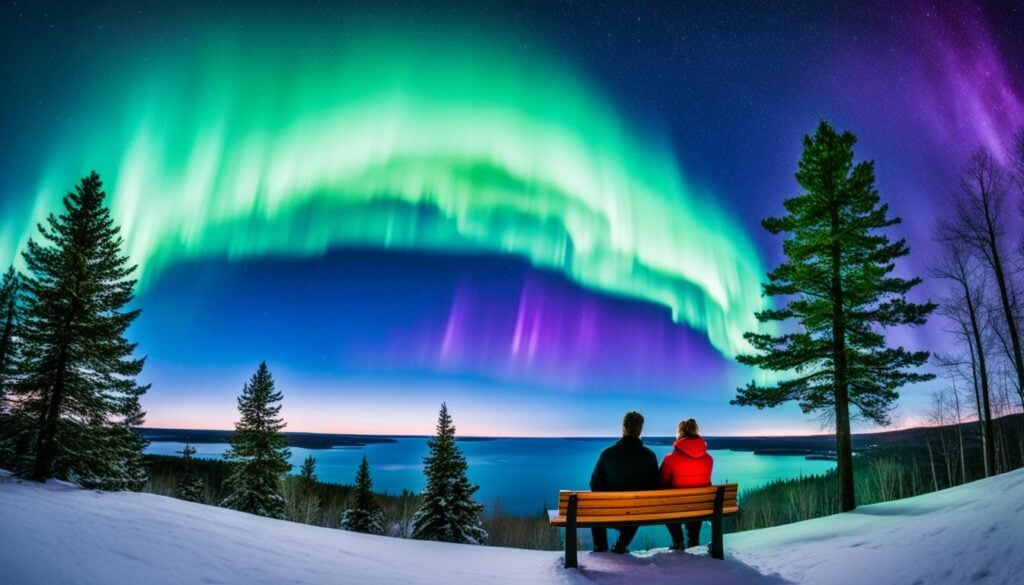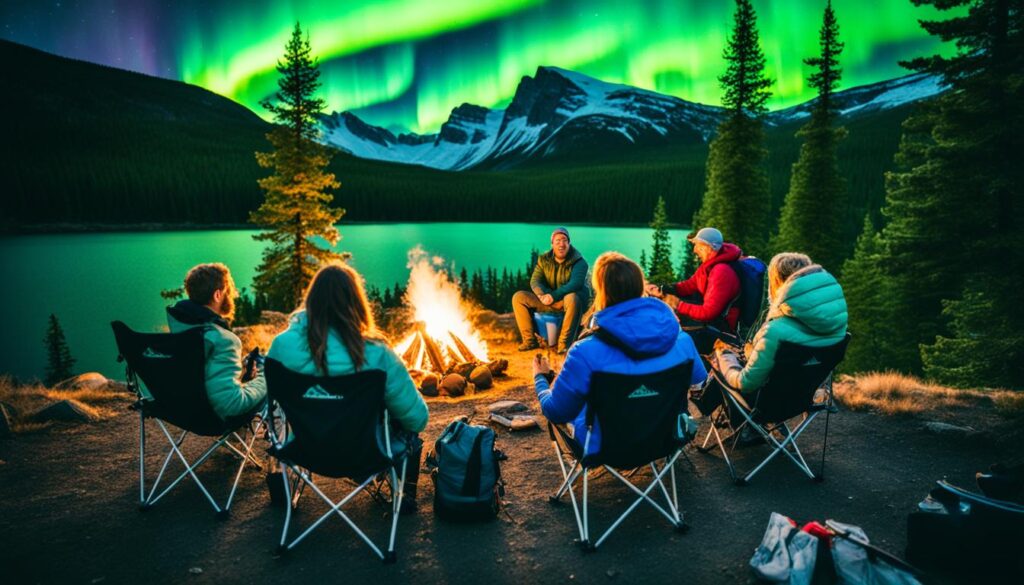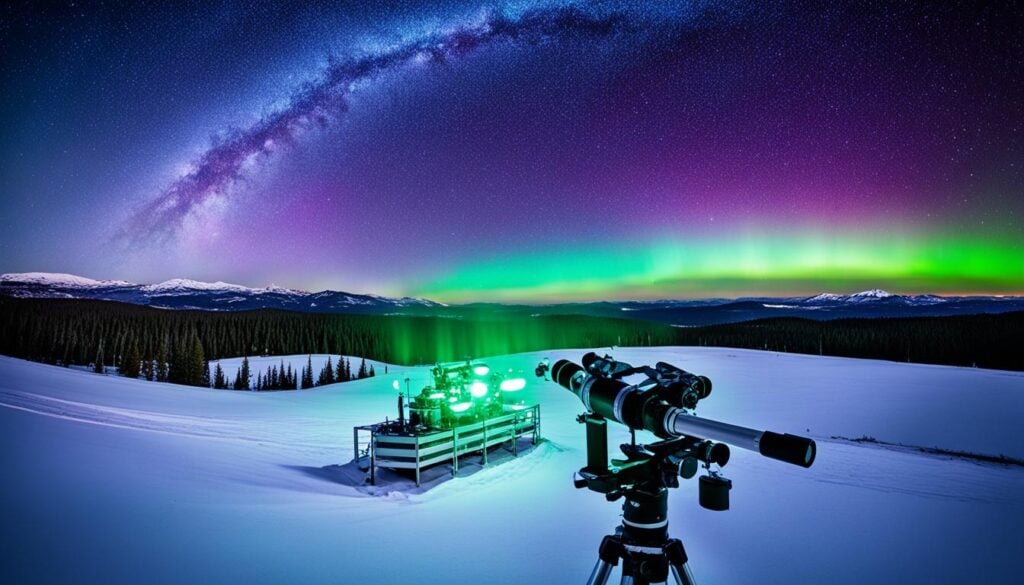Have you ever wondered if Duluth lets you see the Northern Lights? This amazing scene, known as the Aurora Borealis, attracts thousands to Duluth’s skies. Many hope to see the beautiful greens and purples. Knowing the best conditions to see them is key for a memorable time.
This guide will help you understand when and where to see the Northern Lights in Duluth. We will look at geography and weather. They both affect your chances of seeing the lights. Let’s start your journey to see the stunning Northern Lights!
Understanding the Northern Lights
The Northern Lights are a stunning show in the sky, known scientifically as the Aurora Borealis. To truly understand them, we need to look into the science that makes them happen. They’re not just random lights; they come from a specific process and are affected by the environment.
What Causes the Aurora Borealis?
The Aurora Borealis happens when solar wind meets Earth’s magnetic field. Solar wind is made of particles the sun sends out. When these particles hit the Earth’s atmosphere, they light up the sky. The colors can be green, pink, or violet. More solar activity means brighter lights. Also, being near the poles makes them easier to see.
Significance of the Northern Lights in Culture
The Northern Lights mean more than just science. People have given them deep meanings throughout history. Many Indigenous cultures see them as spirits of ancestors or nature’s energy. Norse mythology saw them as a bridge to the gods. Knowing these stories makes the lights even more special.
Can You See the Northern Lights from Duluth?
Understanding how to see the Northern Lights in Duluth is key for anyone looking to see the amazing Aurora Borealis. The mix of location, height, and city lights plays a big role. This affects if you can see this beautiful display.
Geographical Factors Affecting Visibility
Duluth is in a good spot for seeing the Northern Lights. It’s around 46.8 degrees north, putting it in the auroral oval. This is where you’re most likely to see auroras. Also, being higher up means you can see more of the sky. Studies show that the higher you are, the clearer your view will be.
Light from cities can also make it hard to see the Northern Lights. In Duluth, go to places with less city light. This will help you see the lights better.
Optimal Locations for Viewing in Duluth
To see the Northern Lights better in Duluth, check out these places:
- Park Point Beach – It has wide views and less city light.
- Spirit Mountain – Offers height and low light interference, great for seeing the lights.
- Aurora Albrecht Nature Center – It’s quiet, surrounded by nature, and offers a clear sky view.
Picking the right spot and knowing where you can see the Northern Lights in Duluth will boost your chances. Get your equipment ready and keep up with aurora forecasts for your night adventure.
Best Time to See Northern Lights in Dulher=”blank”>Duluth
Finding the best time to see the Northern Lights in Duluth is key to a great experience. The season and moon phases affect how well you can see them. Knowing this can help you plan a better trip.
Seasonal Patterns and Weather Considerations
Duluth is a prime spot for catching the Northern Lights. Fall and winter are the best seasons for this. You’re more likely to see the lights from September to April.
Clear skies are crucial for a good view. It’s important to watch the weather. Nights with little cloud cover and low humidity are perfect for seeing the auroras.
Moon Phases and Their Influence on Visibility
The moon’s brightness can affect your view of the Northern Lights. Full moons can make the auroras harder to see. It’s better to plan your visit during a new moon or when there’s a crescent moon.
Keeping an eye on the moon cycles can help. This way, you’ll pick the best time to see the lights at their best.
Duluth Northern Lights Forecast
Keeping up with the Duluth Northern Lights forecast is crucial for aurora enthusiasts. There are various tools for monitoring solar activity and predicting when the auroras will be visible. Learning to use these tools can greatly increase your chances of seeing the Northern Lights.
How to Access Aurora Forecast Tools
There are many apps and websites with Aurora forecast information. Here are some trusted sources:
- NOAA Space Weather Prediction Center: Offers real-time data on solar winds and KP Index values.
- AuroraWatch: Provides alerts and forecasts tailored to your location, including Duluth.
- My Aurora Forecast: A mobile app offering personalized alerts and detailed forecasts.
Interpreting KP Index for Planning Your Outing
The KP Index, from 0 to 9, shows geomagnetic activity’s strength and its effect on aurora visibility. Knowing how to read the KP Index will help you plan your Northern Lights excursions better. Here’s a quick guide on understanding the scale:
| K Index | Activity Level | Expected Visibility |
|---|---|---|
| 0-1 | Very Low | Not visible |
| 2-3 | Low | Rarely visible, possible near the poles |
| 4-5 | Moderate | Possible visibility in some northern areas |
| 6-7 | Strong | Good visibility expected in many areas |
| 8-9 | Extreme | Widespread visibility, excellent conditions |
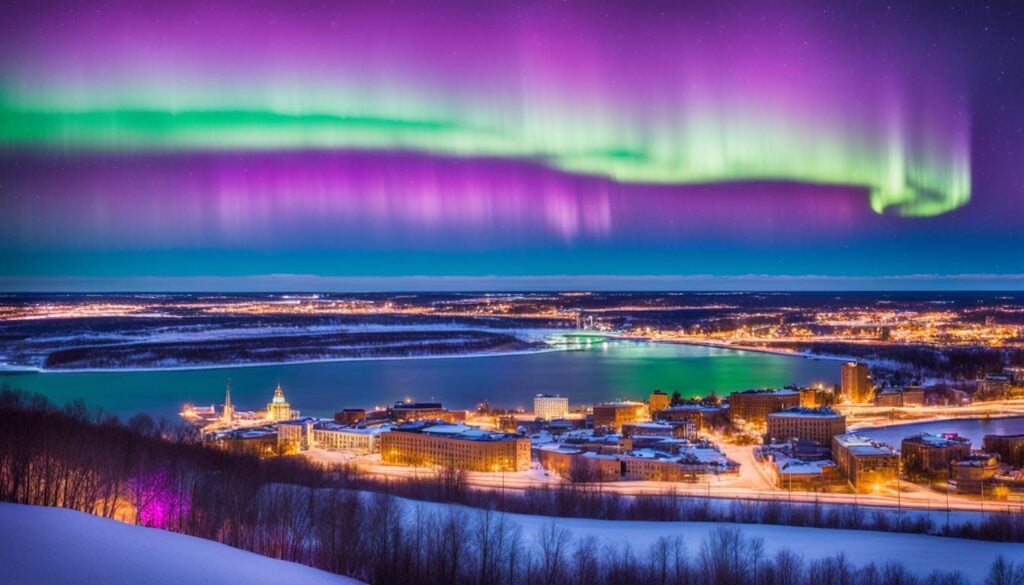
Northern Lights Viewing Tips
To have a great time watching the Northern Lights, getting ready is key. Know where to go and what to wear to improve your chances of seeing the amazing Aurora Borealis. These tips will help make your Northern Lights viewing unforgettable.
Choosing the Right Location for Maximum Impact
The best locations for visibility are crucial for the full Northern Lights show. Think about these when picking your spot:
- Avoid city lights: Look for places far from city light pollution.
- Elevated positions: High ground offers clear views of the sky.
- Water bodies: Being near lakes or rivers can make the auroras even more beautiful.
- Local insights: Talk to locals or tour guides for the best spots.
Preparation for Weather Conditions
Being ready for the weather is important when viewing the Northern Lights. The cold night can challenge even the keenest watchers. To stay warm, follow these tips:
- Dress in layers: Start with thermal underwear, add warm layers, and a waterproof jacket.
- Wear appropriate footwear: Choose insulated, waterproof boots for warm, dry feet.
- Bring cozy accessories: Don’t forget hats, gloves, and scarves for extra warmth.
- Pack essential gear: Bringing chairs or blankets can make waiting comfier.
Photography Tips for Northern Lights
Capturing the Northern Lights is magical. It needs some prep and the right steps. With good gear and knowing your camera settings, you’ll take amazing pictures.
Essential Gear for Capturing the Moment
Having the right tools is key for shooting the aurora. Make sure to have:
- Tripod: A reliable tripod prevents camera shake during long exposures.
- Camera: Use a DSLR or mirrorless camera for better photos in low light.
- Wide-Angle Lens: Choose a lens with a wide aperture to let in more light, which is crucial for night shots.
- Extra Batteries: The cold can drain batteries fast, so having extras is a must.
- Remote Shutter Release: This device helps you take photos without touching the camera, reducing shake.
Camera Settings and Techniques for Stunning Shots
For vivid Northern Lights photos, get to know these important settings:
- ISO: Begin at ISO 800. Adjust if you need. Higher ISO makes your camera more light-sensitive but might add noise.
- Aperture: Go for the widest aperture (f/2.8 or lower). It brings in more light to your camera sensor.
- Shutter Speed: Set it from 5 to 30 seconds, depending on the aurora’s movement. Test to see what works best.
- Focus: Use manual focus and aim for infinity. This keeps the photos sharp.
- White Balance: Manually adjust it from 3000K to 4000K to best show the lights’ colors.
By following these tips for Northern Lights photography, you’ll sharpen your skills. Plus, you’ll create memories of this stunning natural light show that last forever.
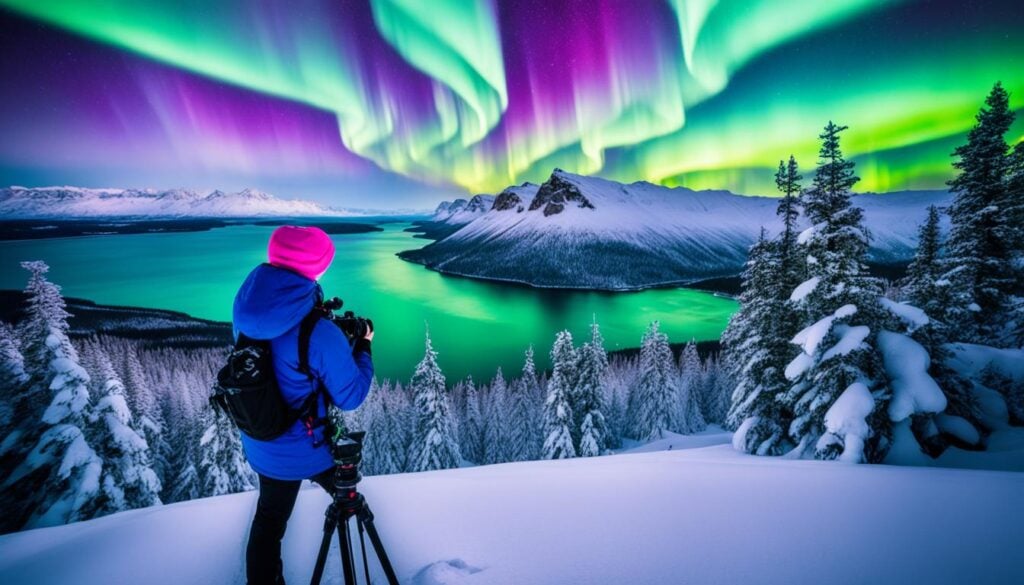
The Science Behind Northern Lights
The Northern Lights are more than just pretty. They are the result of fascinating science. To really get it, we need to look at how the sun’s activities and Earth’s magnetic field work together.
Understanding Solar Activity and Its Effects
Solar activity is key in creating auroras. The sun sends out charged particles during events like solar flares. When these particles meet Earth’s atmosphere, they light up the sky as the Northern Lights. Studying these solar happenings helps scientists forecast aurora shows.
The Role of Earth’s Magnetic Field
Our planet’s magnetic field shields us against solar winds. This field guides solar particles to the poles, sparking the Northern Lights. The magnetic field’s strength and direction affect the auroras’ brightness and location. Grasping this helps us understand the lights better.
| Solar Events | Effects on Auroras | Timeframe for Visibility |
|---|---|---|
| Solar Flares | Increase in charged particles | Immediate to a few days |
| Coronal Mass Ejections | Intense auroral displays | 24 hours to several days |
| High Solar Activity | Widespread aurora visibility | Days to weeks |
Local Tours and Experiences for Northern Lights Viewing
Seeing the Northern Lights in Duluth can be amazing. One of the best ways to see this wonder is by going on tours. There are many tours in Duluth for all enthusiasts, whether it’s your first time or not. These tours take you to the best spots for viewing and help see an amazing display.
Recommended Tours in Dulthan
Many reputable companies in Duluth offer special tours for the Northern Lights. You can enjoy local viewing experiences with expert guides. They know a lot about the aurora. Some tours even teach you how to take amazing photos of the lights. Being with other enthusiasts makes the adventure special.
What to Expect on a Guided Northern Lights Tour
Joining a guided tour for the Northern Lights means a well-planned trip. Tours start in the evening when it’s best to see the lights. You’ll get warm gear and enjoy campfires while waiting for the show. A guided tour makes watching the Northern Lights unforgettable, whether you’re taking photos or just watching.

































